Before I can start analysing GDDs to gain a further understanding of the layout and aspects that I would need to explain my game the best, I must first state what a GDD is, the goals of this document, elements and basic segments that need to be included.
What is a GDD
A GDD, a Games Design Document, is a document that acts as a reference point for the development team to ensure consistency across all departments. This document should contain detailed information on all aspects of a game. Aspects of a game that it should include are: art bible, world bible, narrative bible, sound bible, writing samples, ludic design, and platform specification. A comprehensive GDD should be a set of ‘design pillars’ that must be fulfilled, creating a reference point for all teams to look at for designing information, rather than asking questions to a team leader but taking the initiative instead. This should be a living document, a file that is consistently updated and revised to reflect new additions and changes, this is sometimes referred to as a dynamic document.
Goal of a GDD
The GDD should answer questions for your team so that the team leader doesn’t need to give them an answer, giving your team members independence whilst they work:
- What is the game? – Main concept
- What the players will experience – Gameplay mechanics.
- Why is this game being made? – Goals for the game
- How will I entice the player? – Planned progression
Elements of a GDD
- Summary -> Game concept, genre, target audience, project scope
- Gameplay -> Objective, game progression, in-game UI
- Mechanics -> Rules, combat, physics
- Game elements -> Worldbuilding, story narrative, characters, locations, level design
- Assets -> Music, sound effects, 2D/3D models
Expanded Segments of a GDD
- Overview -> High concept, genre, purpose, niche, message/impact, vibes
- Gameplay -> What kind of experience are you scaffolding for players?
- Story -> Gameworld, lore, narrative, writing samples
- Art -> Character, objects, environments, UI, perspective
- Mechanics -> Verbs, rules, win & fail states, inventory/economic/combat systems, physics
- Levels -> Skill trees, maps, puzzle evolutions
- Sound -> Music, extradiegetic sounds, intradiegetic sounds, voice
- Platform Specification & Control Mapping -> Game feel, engine, player demographics
- Market -> Player communities, monetization strategies, marketplace positioning

The iconic game series ‘Diablo’, an action-roleplaying dungeon crawler game, released its original GDD during GDC 16.
I feel like analysing a GDD from an iconic game series would help me create a great document of my own as I can find features that Condor included to help explain their game to help get development started and investors interested in their project.

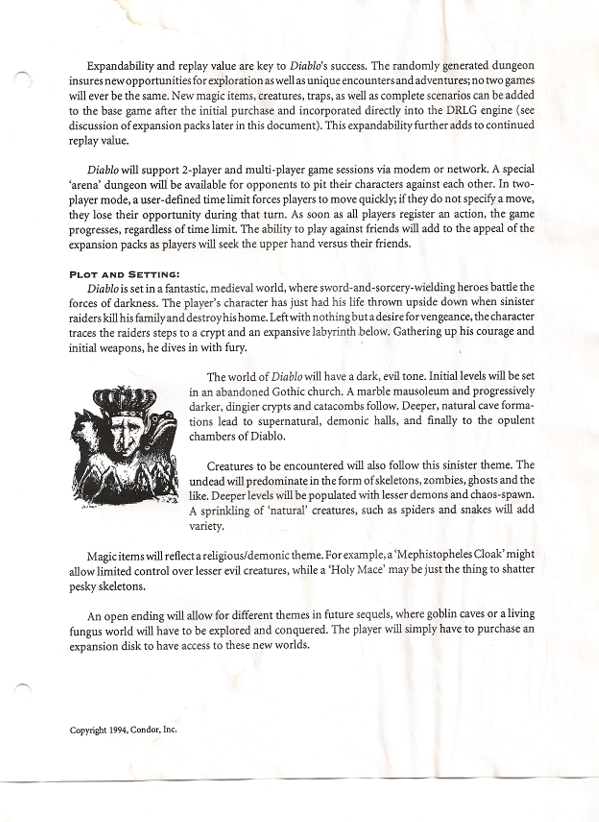
Condor starts by stating what genre and console this game would be playable on. They continue to delve into the feel and emphasis’ of the game and why it would be beneficial to create as it “fills a neglected niche”. After the initial introduction to the game, it continues onto the game design section, specifically the overview.
The overview explains the main goal of the game and what format it will take place in. It explains the core mechanics of the game and how it operates, what peripherals are used to control actions and what the player could use to aid their adventure. It follows with what the player’s choices are like and what their character will have that is special to them. It also talks about why this will make the player enjoy the game with items they could acquire throughout their journey. They continue to talk about how the game will work and what kind of generational levels they will have, the set pieces that will be in the map design and how it will impact the players’ experience for the better.
The next page continues this, expanding on the replayability of their game and how it gears their success, cementing how their mechanics and level generation choices will aid in this. It goes on to mention how their game can be played single-player or multi via network hosting. They also talk about how they will expand the experience of multiplayer through a special game move, then it goes into detail about how this mode will technically work. The appeal of these modes is also talked about, aiding in the previously mentioned replayability of the game.
They then went into the narrative of the game, the plot and the setting subsection. They talk about the setting of the game first and the characters’ story before the beginning of the game. The worldbuilding then gets talked about, talking about the visual side of the areas. The characters and creatures of the game’s planned aesthetics were then talked about, with the physical forms and how a variety will occur through the designers’ choices. Then the items the player will use are talked about, and how it will reinforce and reflect the setting of the game and their uses are stated. The end state of the game and how it’s an ‘open ending’ will allow for a sequel to be made, enticing investors for how successful they expect the game to be to then become a series.
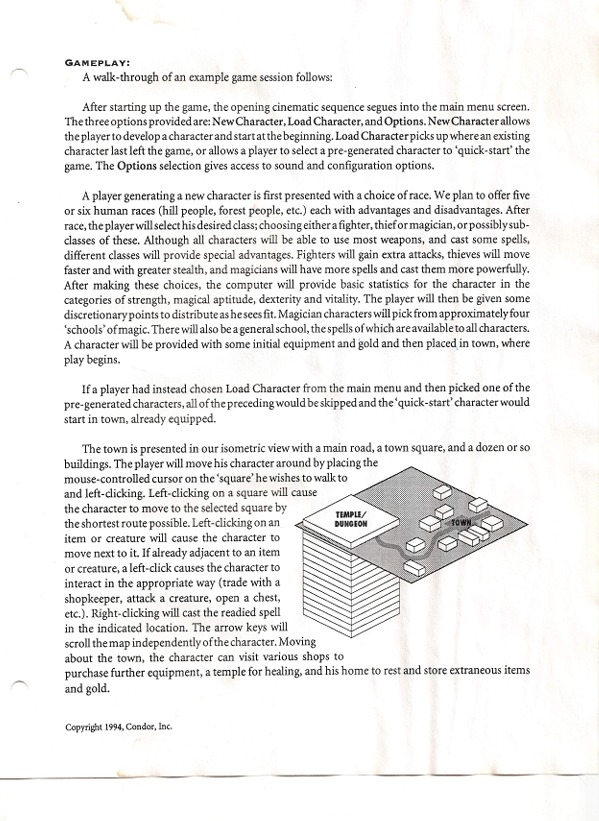
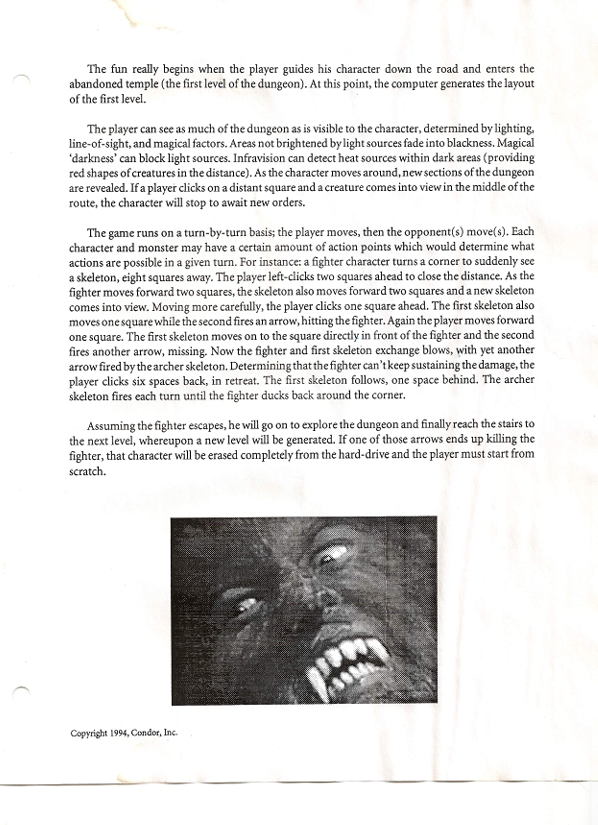
The gameplay subsection of this GDD spans over two pages, going into vigorous detail about how the game will pan out. It talks step by step about the experience the player will go through from launching the game, their options on the menu screen, the save mechanic and sound and configuration options.
The character customisation section is then discussed. How many races do they plan to offer explaining the advantages and disadvantages of each one. What they can use and what they can’t use. The skill point system of statistics for the characters’ advantage is then discussed, these will affect their actions during gameplay. They then talk about the presentation of the levels, the camera view and how the player will traverse this area. They then talk about the controls when interacting with the environment how the uses of the shops in the environment and what the players will gain by using them.
They cement the idea of fun by continuing to talk about the first level of the game, what the player will see of the environment, how it will be lit and line-of-sight. They also talk about the turn-based combat within the game, how it works, the action point system of attacks and how the computer-controlled enemies will take their turn too. They then talked about how the player will progress if they succeed in their battle and how the next level will be introduced.
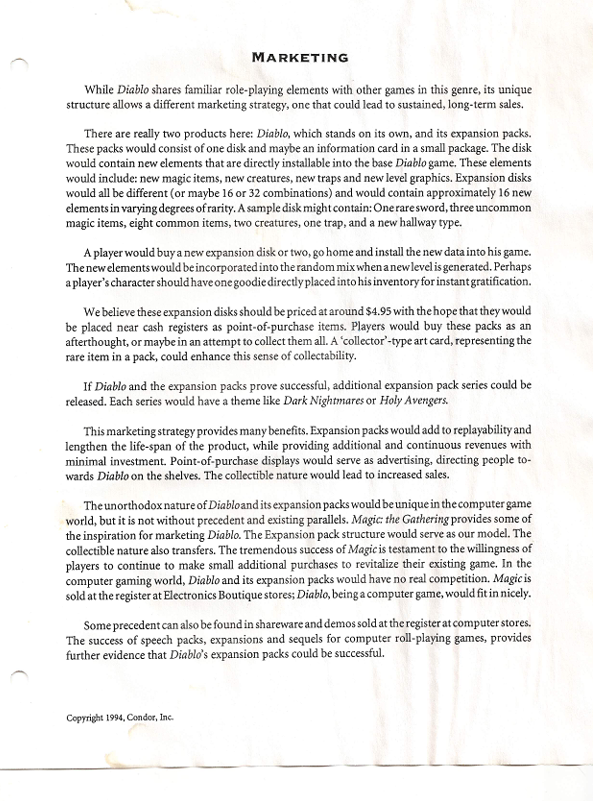
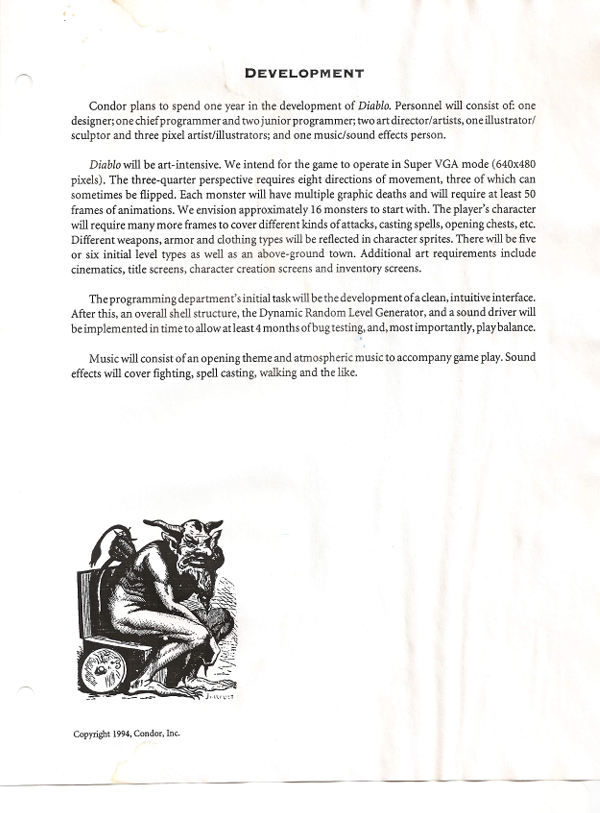
After talking about the technical side of the game, the Condor then goes onto the section of marketing as this plays a big part in the engagement of the game and how it will be perceived by the general public. They promise sustained long-term sales through their marketing plan. This whole section talks about how the addition of expansion packs will aid in this vision and replayability, the pricing of these packs and the possible themes of them. The unique aspect of this is how they say they will serve advertising of the game and the collectable possibility that it would lead to increased sales. They also plan to release demos to build up hype around the game.
Development is the last section, they state how many people they want on different development sections of the game, how it will be art-intensive and what it would run on. They also give estimates of how many animation frames they will need for specific actions, level types, sprites and creature count. They then briefly talk about the initial tasks that the programming team would need to undertake to allow for bug testing and play balance. They then finish off with a brief talk about music and atmospheric sfx for spell casting etc. The image is not included as it doesn’t concern my GDD but they did also include a timeline that they expect the development stages will take to produce.
Following the analysis of an existing GDD I now have an idea of what I should try to include within my own Games Design Document. I have made a list to aid me in further development of my Document:
1. Introduction
- Genre and Platform: Clearly state the game’s genre and the platforms it will be available on.
- Game Feel and Unique Selling Point: Describe the tone, atmosphere, and emphasis of the game, highlighting how it fills a niche in the market.
2. Game Design Overview
- Main Goal and Format: Define the game’s objectives and its core structure.
- Core Mechanics: Detail how the game operates, including player interactions, controls, and supporting peripherals.
- Player Choices: Explain the decision-making elements, unique character traits, and their impact on the player’s journey.
- World Design: Describe generational levels, map features, and set pieces that enhance gameplay.
3. Gameplay Mechanics
- Player Journey: Provide a detailed step-by-step walkthrough of the player’s experience, from launching the game to in-game activities.
- Menu and Options: Include save mechanics, configuration options, and accessibility settings.
- Combat System: Outline how combat works, including mechanics like action points and enemy AI turns.
- Progression: Explain how success in gameplay leads to advancing levels and introduces new challenges.
4. Character Customization
- Playable Races and Attributes: Discuss available races, their strengths and weaknesses, and customization options.
- Skill Point System: Explain how stats affect gameplay and the player’s advantage in different scenarios.
5. Environment and Interaction
- Level Design: Highlight visual elements, lighting, and how players navigate through levels.
- Environmental Interaction: Detail shop mechanics, items, and their benefits to players.
6. Replayability and Multiplayer
- Replayability Features: Describe level generation and mechanics that encourage repeated play.
- Multiplayer Modes: Explain single-player and multiplayer options, including network hosting and special modes to enhance the experience.
7. Narrative and Worldbuilding
- Plot and Setting: Provide a synopsis of the story, setting, and character backstories.
- Aesthetics: Outline visual and thematic elements of characters, creatures, and environments.
- Item Integration: Explain how items reflect the game’s setting and their functionality.
- Endgame and Sequel Potential: Present the game’s open-ended nature to suggest franchise opportunities.
8. Marketing and Expansion
- Marketing Strategy: Discuss plans for sustained sales, including demos, expansions, and collectable features.
- Expansion Packs: Outline pricing, themes, and their role in enhancing replayability.
9. Development Plan
- Team Structure: Define roles and team size for different development areas.
- Technical Details: Provide estimates for animations, sprites, and level designs.
- Programming Tasks: List initial tasks to prepare for bug testing and balancing.
- Audio Design: Briefly touch on music and sound effects.
10. Timeline
- Development Phases: Include a timeline or roadmap for development stages to ensure project milestones are met.
The last two sections, 9 and 10, might not be necessary for mine but I think it is useful to have just in case I would want to include it if I have time and if it benefits the understanding of my document for others.